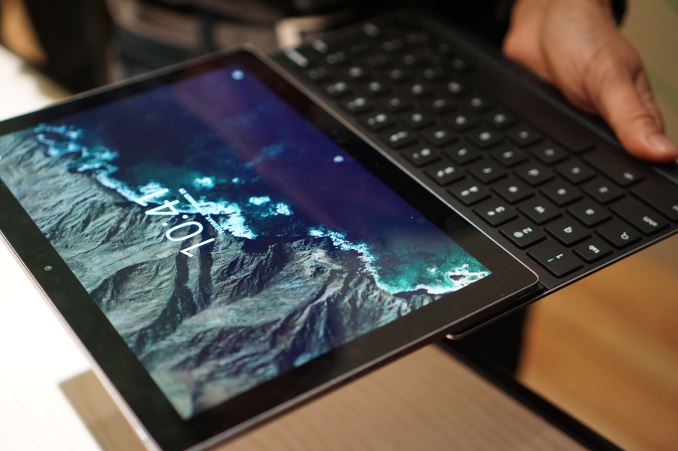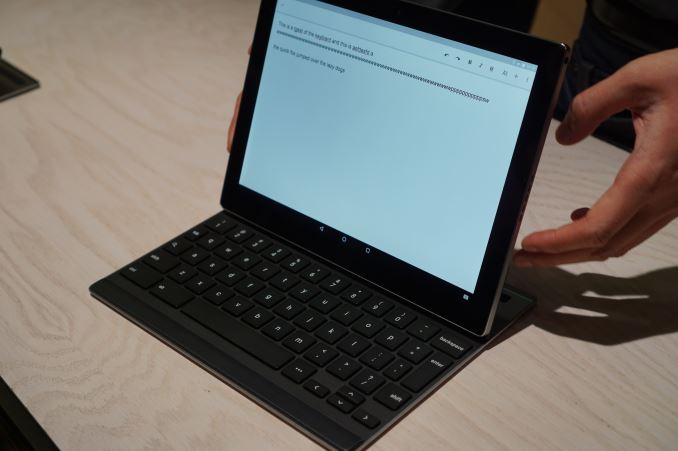Google Announces The Pixel C Tablet
by Brandon Chester on September 29, 2015 6:45 PM EST
In addition to the new Chromecast devices and new Nexus phones, Google gave the world a sneak preview of a new Android tablet which they call the Pixel C. Like the Chromebook Pixel, the Pixel C is designed completely in-house by Google, and it shares many attributes with the Chromebook Pixel even though it runs Android rather than Chrome OS. The hardware is also very interesting, and while there are many unknown details about the Pixel C, what is known looks promising.
As far as specifications go, the Pixel C has a 10.2" IPS display with a resolution of 2560x1800, which equates to a pixel density of 308ppi. Google states that the tablet's aspect ratio is the square root of two, and that's pretty much accurate as 2560/1800 is around 1.42. Representatives at the event stated that the display uses an LTPS backplane rather than an a-Si one, which allows for higher brightness and greater efficiency. Manufacturing LTPS displays at this size costs a considerable amount and it seems that Google felt it was necessary in order to achieve their 500 nit brightness.
As for color, Google advertises that the display covers the sRGB color gamut. I stated this in my live blog, but it's worth repeating that gamut coverage is only loosely correlated with color accuracy. The 2015 Chromebook Pixel covers the sRGB gamut, but is significantly less accurate than a laptop like the MacBook or the QHD+ XPS 13. Based on what I saw at the event, Google has put effort into making sure their new Nexus devices are well calibrated. However, they've also shown lacking effort in doing the same for their $1000 Pixel-branded laptop. I'm very interested to see how accurate the Pixel C's display is, and I'm hopeful that it can stand alongside the new Nexus smartphones and the Nexus 9 when color accuracy is considered.
Inside the Pixel C is NVIDIA's Tegra X1 SoC. Built on TSMC's 20nm process, the X1 packs a quartet of ARM Cortex A57 cores backed by 2MB of L2 cache, and another four A53 cores backed by 512KB of L2 cache, with NVIDIA balancing between performance and power efficiency. Meanwhile the GPU is a 256 core Maxwell implementation that should more than give other Android tablet SoCs more than a run for their money judging from what we've seen in other X1 devices.
It's hard to guess what we're dealing with in terms of clock speeds and TDP, as this is the first time that X1 has shown up in a mobile device. Ryan and Josh have done some previous analysis of X1, and so far the X1 has only been used in the SHIELD Android TV review, an Android TV console built to service 4K video playback and 1080p(ish) native gaming. Compared to the set-top Android TV, performance will obviously differ in a power and thermally constrained situation like a tablet - though by how much remains to be seen - and in any case the X1 remains as one of the most powerful Android tablet SoCs on the market at this time.
While launching the first Tegra X1 mobile device is quite a big announcement, the focus of the Pixel C is actually on the keyboard accessory that you can purchase for it. For Google, the Pixel line has always had a focus on providing users with great build quality, great keyboards, and great trackpads. The Pixel C is no exception, as it has a new bluetooth keyboard accessory designed to work specifically with it. While Apple and Microsoft have opted for soft keyboard covers, Google has decided to make their keyboard accessory out of the same aluminum as the tablet's chassis. This means that there really aren't any compromises as far as key feeling, size, and travel distance are concerned. The keyboard really looks and feels like a slightly condensed version of the Chromebook Pixel's keyboard, with only the lesser used keys around the edges being less than full size.
Almost as important as the keyboard itself is how it works with the tablet. Some devices use a kickstand, while others use the cover itself for support by folding. Google decided to come up with their own way, and when you see it in person you can't help but admire its elegance. The keyboard cover attaches to the tablet magnetically. You can store it on the front to make it like a folded laptop, or on the back when you just want to hide it. When it's on the back you can simply pull the tablet to one side, which shifts the magnetic connection and allows you to elevate the tablet and use it just like a laptop. It's really difficult to describe, but it works incredibly well and allows for a tilt range from 100 to 130 degrees without any sort of kickstand.
Since the keyboard connects via Bluetooth, it does need to be recharged. However, Google has come up with a method of doing so that is as elegant as the keyboard itself. While it's attached to the face of the tablet the small internal keyboard battery is charged inductively by the tablet itself. Having it in that position for only a few minutes a day allows it to stay charged perpetually, and the battery will last up to two months on a single charge. It's just a really ingenious solution and I'm really impressed by it.
The Pixel C is the next device in an emerging category of tablets that sit between your traditional tablet and traditional laptop. How users will respond is anyone's guess, but the Pixel C isn't priced at the extreme high end of the market like Chromebook Pixel is so it should be more accessible to consumers. On the subject of price, the Pixel C will start at $499 for 32GB, and $599 for 64GB, with the keyboard being a $149 accessory.



















58 Comments
View All Comments
lilmoe - Tuesday, September 29, 2015 - link
In my case, I don't get the Chromebook Pixel because, well, it's too damn expensive for what it can do. But Pixel C can be easily thought of as, you know, a sequel to the Nexus 9?Spectrophobic - Tuesday, September 29, 2015 - link
You could think of it as that, but I'd rather have them make an X1 version of the Shield Tablet. You know, a media tablet with 16:10 aspect ratio, a stylus, front-facing speakers, and other high-end Android tablet stuff etc... Just Google-branded.sonicmerlin - Tuesday, September 29, 2015 - link
Uh... Probably a sequel to the nexus 10, considering this is 10".Wolfpup - Wednesday, September 30, 2015 - link
Yeah, but the Nexus 9 is the replacement for the 10, and I'd think this is the replacement for the 9. Slightly bigger screen + a bump to the newest Nvidia SOC.Dragonphire - Saturday, October 31, 2015 - link
Honestly for me I never considered the Nexus 9 a true replacement for the Nexus 10. This is strictly due to screen size. The Nexus 9 to me was a competitor to the Amazon 8.9 HDX and iPad Mini. I must pay for the 10 inch or larger market for tablet. I recently had a 12.2 tab app pro and love didn't however I had to give it up due to performance issues. Just recently I started to get into the Nexus branded equipment. I am now the proud owner of a Nexus 9, Nexus 7, and a nexus 10. And also a 10.5 inch tablet. I guess you could say I like tabletsdigiguy - Tuesday, September 29, 2015 - link
Happy to see high-end tablets in a market full of cheap Android slates. What a pity that google didn't go with a larger screen (this aspect ratio would have been great for reading ebooks etc.). Anyway, I am curious to know the weight of the device (and the combined weight with the keyboard). Having said that, lots of people (including me) were complaining about the overpriced Surface type cover, now we have 2 even more expensive keyboards by Apple ($169) and Google ($149). This reduces to zero chances that Microsoft is going to lower the price of its type cover or even bundle it with SP3/4...squngy - Wednesday, September 30, 2015 - link
You don't need a large screen for reading ebooks.Fiernaq - Wednesday, September 30, 2015 - link
Speak for yourself. For someone who reads quickly, having to turn the page every few seconds is a huge negative.Wolfpup - Wednesday, September 30, 2015 - link
That's certainly why I prefer for example the Kindle DX's screen size to all the 6" devices!Wolfpup - Wednesday, September 30, 2015 - link
You do for magazines and graphic novels. 10" is kind of doable but too small to replicate a printed page.The other issue though is how *DIM* the backlight can get. I've not seen a single Android tablet that can get dim enough for reading in the dark.